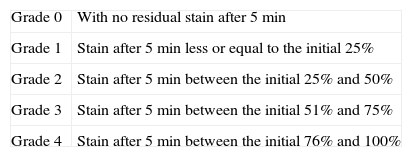Our objective was to compare the results of probing with and without endoscopy in cases of congenital nasolacrimal duct obstruction without prior probing.
MethodsThis was a retrospective analysis on 2 non-randomized cohorts, 36 simple soundings (group 1) and 36 soundings with endoscope (group 2), between January 2011 and January 2013. Both groups were similar in age and had no previous surgery. The age of the patients studied ranged between 8 and 27 months in the first group and between 7 and 30 months in the second group.
ResultsThe procedure was successful in 50% of the conventional probing group and in 97.22% in the endoscopy probing group. In this group 16.67% of the patients with tight inferior turbinate and 11.11% of those where the probe passed into the submucosal space were diagnosed and corrected intraoperatively. Some anomaly was observed in 30.56% of the patients undergoing endoscopy.
ConclusionAlthough nasal endoscopy is classically reserved for unsuccessful probing, its use in primary intention increases the success rate of the procedure. In our study, 97.22% of the eyes had complete resolution of symptoms, avoiding a second surgery and the use of more expensive materials and techniques. Nasal endoscopy helps intraoperative visualization, understanding and management of congenital nasolacrimal duct obstruction and is the only method that confirms the correct anatomic position of the catheterisation in real time.
Comparar los resultados de dos series de sondajes de primera intención, sin y con endoscopia nasal, acompañados en este segundo caso de luxación de cornete inferior y corrección de enfermedad del meato inferior si la hubiera, en casos de obstrucción nasolagrimal congénita.
MétodosSe practica un estudio de cohortes retrospectivos con 36 sondajes simples (grupo 1) frente a 36 sondajes con endoscopia (grupo 2), entre enero de 2011 y enero de 2013, en 2 grupos de población parecidos sin intervenciones previas. El rango de edad fue entre 8 y 27 meses en el grupo 1 y entre 7 y 30 meses en el grupo 2.
ResultadosEl 50% de cirugías lagrimales fueron realizadas con éxito en el grupo de los sondajes sin endoscopia, frente al 97,22% en el grupo guiado por endoscopia. En el grupo 2 se diagnosticó y corrigió intraoperatoriamente un 16,67% de vías lagrimales con aposición del cornete inferior en su porción distal y un 11,11% de falsas vías o trayectos submucosos.
En un 30,56% de los sondajes practicados con endoscopia se observó más de una anomalía nasolagrimal, tanto a nivel del canal como en el meato inferior, que influía negativamente en su funcionamiento.
ConclusiónAunque clásicamente se ha reservado la endoscopia para fracasos quirúrgicos en reintervenciones, su utilización de primera intención mejora significativamente los éxitos. En nuestra serie un 97,22% tuvieron resolución completa de los síntomas, evitando un segundo paso por quirófano y la utilización de materiales y técnicas más costosas. Nos ayuda a la visualización y compresión de esta enfermedad y es el único método para confirmar directamente un correcto sondaje en tiempo real.













